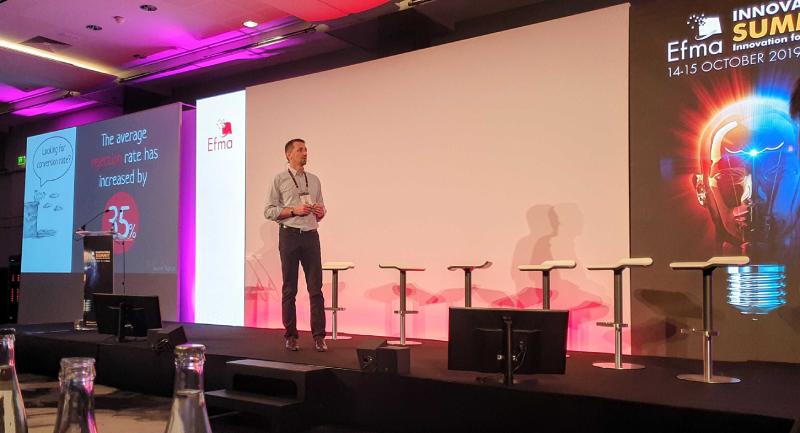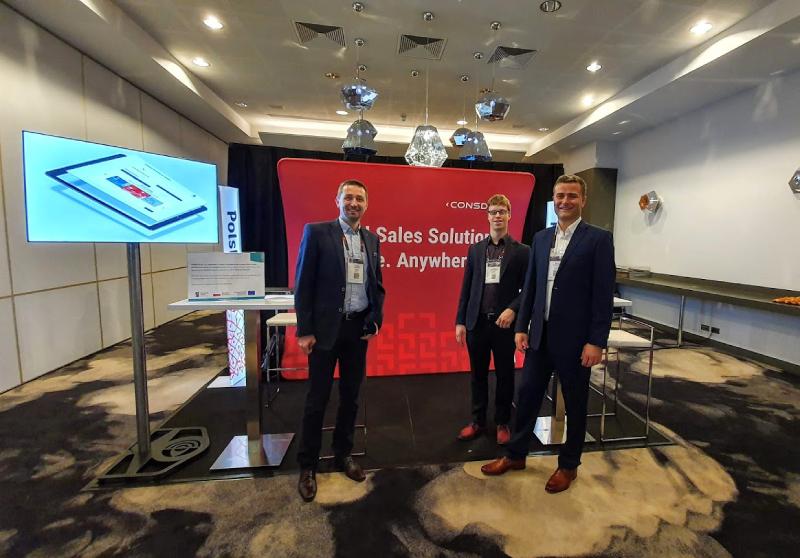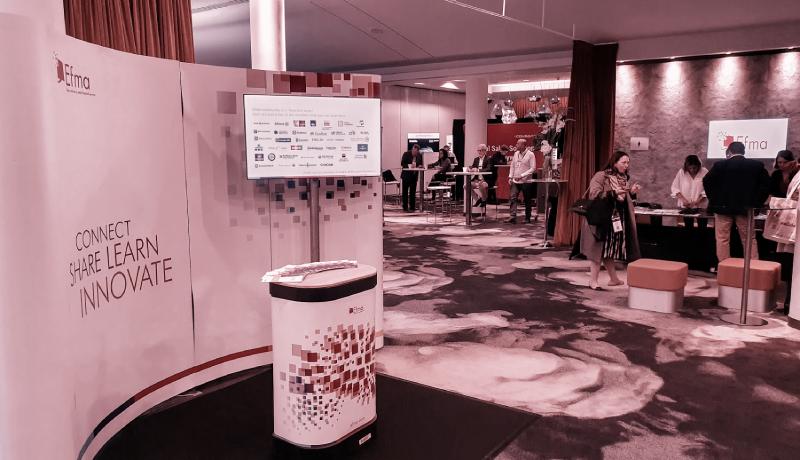"If we are now in the calm before the storm, what will we do to fly in the storm? Because no one wants to fall down."
With this interesting phrase Maike Strudthoff started the substantive part of the conference. It was a very energetic and introductory presentation, which perfectly presented the place where the banks are now when it comes to innovation. A lot has already been done in various banks, but can we honestly say that most of the banks on the market function in an innovative way? We cannot yet. The era of innovation is still ahead of many banks. On the other hand, technologies are changing so quickly that we can say that we are in the calm before the storm. So what can we do to fly through the storm, not to fall? Other speakers of the conference tried to answer this question.
What is the innovation in banking?
Even before the conference I had sent a message to several participants via LinkedIn. I asked them if they agree with the statement that the word "innovation" in banking has many meanings and for every bank it may mean a slightly different thing. Many people who discussed it with me agreed with this statement. The same impression could have appeared in the minds of the conference participants. The definitions of innovation were different, depending on the speaker's country of origin or the organisation he represented. However, I must stress that each of these definitions is good - everything depends on the context.
So we could hear, on the one hand, that "Innovation is not have to be disruptive. Maybe it is to make banking simpler." as the famous Jim Marous said. What's more, Carlos Lopez-Moctezuma even said that "Digital ecosystems doesn't mean that the only way is to make only digital banking. In many countries branches are still significant so digital ecosystems must contain branches too." On the other hand, we have heard about blockchain technologies, without which Demetrio Migliorati cannot imagine innovation, and about the fact that in order to be innovative, one has to take risks. "Don't play it safe. If you want to innovate, you must take the risk". Michael Anyfantakis
However, many speakers stressed that innovation cannot exist on its own. The above-mentioned Jim Marous even said that "innovation and digital transformation are highly correlated". Monika Edlinger further explained this perspective on innovation in banking. She said "innovation have to be structured". Our speaker, Tomasz Ampuła, agreed with her and quoted the words written by Ron Shevlin in an article in Forbes: "It's the process that matters, not the technology". Taking into account these three speakers, we can therefore conclude that innovation begins in banks by structuring digital transformation processes. It is confirmed in Capgemini's "World Retail Banking Report 2018", in which Capgemini analysts clearly stressed that if banks want to see an increase in Customer Experience and revenue, innovative technologies such as chat bots, AI, etc. must be followed by structured backend processes. Unfortunately, many banks focus only on technologies and not on processes.
One thing is certain. I think all conference participants agreed with the statement of Olga Emideth Cej: "We are completely sure that CX and innovation is the base of our growth". This is the idea behind the fact that over 150 people from over 100 countries around the world met during these 2 days in one place in Paris.
The human factor in the process of creating innovations in banking
Many of the speakers we listened to at EFMA Innovaton Summit concerned people - primarily bank customers, but also employees. "Remember it's all about the people" said Mohcine Ouass and Fernando Torres Figueiredo. It is hard to disagree with this statement. What would innovation be if it did not affect the behaviour of bank customers?
Many speakers stressed how important it is for banks to satisfy their customers and provide them with products in a way they even love. It perfectly reflects the idea of the statement made by Frederic de Melker: "The customer is disrupting us, not we (as banks) are disrupting customers". Albert Llorens Albareda spoke in a similar tone: "We want to be part of the story that everybody is creating around us. So the banking should be kept simple. Should be also meaningful and customer driven. We prefer to put the customer just beside us."
Alfons Cornella, speaking about people, referred to what the innovation is. He put it very aptly that innovation in banking includes 3 components: software, service and value for customers. "But the value is the one which is the most critical. The future of banking is not about technology, is about the value. So you must understand your clients.". He then warned all the bankers on the meeting about the incorrect perception of banking through the eye of the banker: "Most of us are trained to generate the output, but What the people want is outcome."
At this point it is worthwhile to think for a while longer about what bank customers may want. Such was also the question asked by Dara Hizveren "We need to know what really motivates people", and Tomasz Ampuła answered this question. It turns out that what customers expect from banking today is caused by two factors - e-commerce and monkey. We created e-commerce ourselves, as people wanting everything immediately - immediately find, buy and pay immediately. Banks here are making their contribution by integrating online payments with online shops. Monkey, on the other hand, is a concept created by Tim Urban - Instant Gratification Monkey. It is the nature of the human brain that makes us think it's more attractive to have a quicker but lower profit than a bigger but more long-term benefit. It is a phenomenon that is absolutely encoded in our brains and that has a colossal impact on our decisions. So given the coexistence of e-commerce and Instant Gratification Monkey, we can answer the question asked by Dara Hizveren. In general, bank customers are motivated by immediate access to banking products in the omnichannell model. To confirm this, Tomasz Ampuła gave some statistics, which shows that:
- If the bank does not ensure 100% digitization of the sales process, about 1/3 of customers will abandon filling in the application for new products.
- If the bank complicates online sales processes too much, 77% of customers will prefer to go to a branch. However, the question is - will they come to them?

Innovation is ensured by excellent cooperation with other market participants
Several speakers also stressed that one of the important factors that made them successful was cooperation and integration with other banks and financial market participants. Renata Talarico Petrovic spoke very positively about the ecosystem they managed to create at Bradesco "We knew that we have to do an internal innovation and also an open innovation, so we've made an innovation ecosystem".
Michael Anyfantakis mentioned that banks should not compete with each other in terms of innovation, but should support each other, which will only speed up the process of delivering innovation to the banking market. "Explore new horizons together. Collaborate across banks and align to corporate strategy. Banks must collaborate each other if they want to be innovative". As Consdata, we agree with this approach as we have been observing for years how innovations appear in Poland - in one of the most digitally mature markets for banking (according to Deloitte).
Thirdly, banks also have a great opportunity to cooperate with Fintech nowadays. Frederic de Melker emphasized the advantages of such cooperation when he said: "In one hand we have banks. Banks are limited by regulators, time horizon, security etc. On the other hand we have fintechs. They have scale, technology, we can trust them. The thing is to make a good integration to make the customer ecosystem".
Interesting implementations of innovative projects
During several dozen presentations, which took place during the congress, we could listen to the innovations introduced in various banks all over the world. Here are some of them:
Tomasz Ampuła from Consdata emphasized the importance of 100% digitalization of the sales process and recovery of customers who abandoned filling in applications. On the example of implementation of such processes in PKO Bank Polski and mBank, he said how effective such processes are. The first bank managed to implement the annual plan of online sales of cash loans in the first quarter only. The second bank celebrates success by recovering over 22% of customers who abandoned filling in applications.
Marc Balastegui from CaixaBank said about the voice-first strategy in the bank. "We've created the bank of the future and we want to move the next step by voice first by cooperating with Amazon Alexa".
Bartosz Zborowski from PeKaO bank said how much attention he attaches to innovation in the bank. "2 years before we've changed our strategy where innovation takes the great part of it. We've started over 70 digital projects."
Demetrio Migliorati stressed the importance of Blockchain in Banca Mediolanum. "Blockchain can really change the insurance. We've implemented a platform that will positively respond to customer claims in the real-time... Customers can receive their money at the same day when they make they claim".
Ewelina Gulbinowicz spoke about the great role of the personalization of banking services in Alior Bank. "What is really innovative it that our clients can switch plenty of services in their bank account. They can customise our products by themselves."
Juan Franco also mentioned personalization when he said "We found the way to sell more by our own ecosystem of non-financial strategies. Our clients don't have to think about financial services any more".
Manuel Cantalapiedra Astudillo spoke about the great success of the One Pay FX solution.
EFMA Innovation Summit 2019 – The summary
To sum up, EFMA Innovation Summit was a really inspiring event, where we confirmed that for every bank the word "innovation" means something slightly different. However, everyone has a common impression that the implementation of innovative solutions in banking is definitely the future of the banking market.
Finally, I apologise to those speakers I have not mentioned. Unfortunately, my professional duties did not allow me to be at your presentations.
Read also the summary of:






